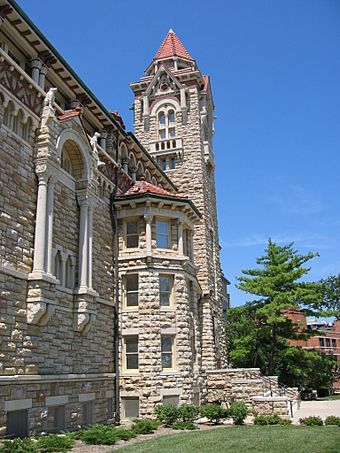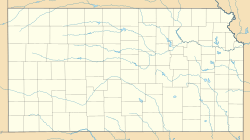University of Kansas Natural History Museum facts for kids
Quick facts for kids |
|
|
Dyche Hall, University of Kansas
|
|

The Museum of Natural History is located in Dyche Hall at the University of Kansas.
|
|
| Location | 14th St. and Oread Ave., University of Kansas campus, Lawrence, Kansas |
|---|---|
| Built | 1901 |
| Architect | Root & Siemens; Bennett, Henry |
| Architectural style | Romanesque |
| NRHP reference No. | 74000829 |
| Added to NRHP | July 14, 1974 |
The University of Kansas Natural History Museum is a special place dedicated to studying all life on our planet. It is part of the University of Kansas Biodiversity Institute, a research center that explores the amazing variety of living things.
The museum's public exhibits are inside a historic building called Dyche Hall on the university's campus in Lawrence, Kansas. The building itself is a landmark. It was added to the National Register of Historic Places in 1974 because of its unique Romanesque style and its connection to a famous explorer, Lewis Lindsay Dyche.

Contents
The Historic Dyche Hall
Dyche Hall is not just any building. It was built between 1901 and 1903 and was designed to look like a church in France. The outside is made of a local stone called Oread Limestone. The details around the windows and the cool, carved figures called grotesques are made from another stone, Cottonwood Limestone.
The building is also home to a Victory Eagle statue. These statues were once used to mark a famous road called the Victory Highway. Only three of these statues are left in Kansas, and one is right here at Dyche Hall!
What Can You See Inside?
The museum has over 350 different exhibits. You can explore amazing displays that show the incredible diversity of life, both past and present.
The Famous Panorama
One of the most famous exhibits is the Panorama of North American Wildlife. This huge display shows animals in their natural habitats. It was so popular that a part of it was shown at the 1893 World's Fair in Chicago. The success of the panorama helped raise the money needed to build Dyche Hall for the museum.
Comanche: A Horse with a Story
The museum is home to Comanche, a horse famous for being the only U.S. Cavalry survivor of the Battle of the Little Bighorn. His preserved body is on display, telling a unique story from American history.
Fossils from Ancient Kansas
Kansas was once covered by a giant sea. The museum has an amazing collection of fossils from this time, known as the Kansas Chalk. You can see the skeletons of giant sea reptiles like plesiosaurs and mosasaurs, as well as flying reptiles called pterosaurs.
Other Cool Exhibits
Newer exhibits include a fascinating display of mammal skulls, a look at the parasites that live on sharks and rays, and ancient artifacts from the pre-Columbian people of Costa Rica.
A World-Class Research Center
The museum is more than just its public galleries. It is part of the Biodiversity Institute, which holds over 10 million specimens. This huge collection includes plants, animals, fossils, and archaeological artifacts.
Scientists from all over the world use these collections to study:
- How different species are related (systematics).
- How life has changed over millions of years (evolution).
- Ancient life forms (paleobiology).
- Human cultures from the past.
The Institute also uses computers to study biodiversity data. This helps scientists understand and even predict changes in the environment. The collections and scientists are spread across six buildings on the university campus.
See also
- Camarasaurus
- Entomology
- Glass Frog
- Presbyornis
- Charles Duncan Michener
- Michael S. Engel
- List of oldest buildings on Kansas colleges and universities



